How Mainline achieved the Windsor Old Traffic Bridge demolition
09 November 2021
In 2019, Australian building and civil construction company Georgiou was awarded a contract to design and construct the Windsor Traffic Bridge Replacement Project.The scope of works for the project, in Sydney, New South Wales, included constructing an incrementally launched three-lane traffic bridge, followed by the Old Traffic Bridge demolition.
In 2019, Australian building and civil construction company Georgiou was awarded a contract to design and construct the Windsor Traffic Bridge Replacement Project.
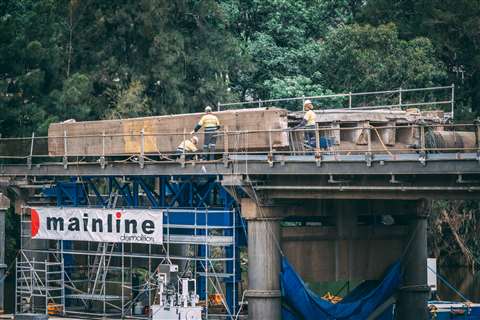 Georgiou Group was awarded the contract to replace the bridge in 2019
Georgiou Group was awarded the contract to replace the bridge in 2019
The scope of works for the project, in Sydney, New South Wales, included constructing an incrementally launched three-lane traffic bridge, followed by the Old Traffic Bridge demolition.
The demolition was executed by Mainline, using what it described as innovative systems to overcome multifaceted challenges of the complex works contract scope.
The demolition scope encompassed:
- Demolition of the existing bridge, except permanent works structures
- Existing bridge piles removed to 1,500 mm (almost 5 ft) below riverbed level
- Retain Windsor South Span 1 and carefully remove walkway, bitumen surfacing, curbing and sundry services
- Maintain without compromise all flora, fauna and built form, abutting South and North bridge road approaches
- No access from South Windsor end.
When deciding the methodology for the bridge demolition, the project team was tasked with removing a 143 m (469 ft) composite concrete and cast-iron bridge over the Hawkesbury River.
Peritas consulting engineers were retained to provide project engineering support in conjunction with local technical support.
Windsor Traffic Bridge Replacement Project’s operational risks
Mainline was determined to remove the structure in 13 m (43 ft) single-span, 12 t sections (120 t) to avoid the many environmental and operational risks associated with segmentation. A LiftnRoll (LnR) apparatus was custom designed to remove the bridge deck.
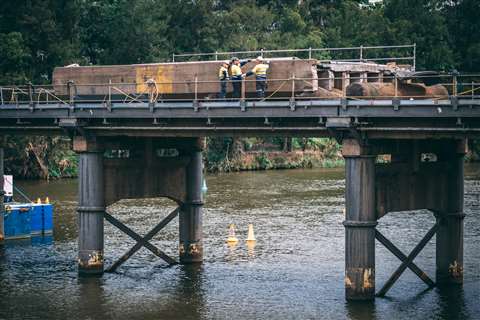 Mainline was determined to take down the bridge in single-span 13-metre sections
Mainline was determined to take down the bridge in single-span 13-metre sections
The LnR apparatus weighed around 21 t and consisted of a jacking frame with lift platform fitted with four dual-action jacking legs fixed to the outer edge of a modular Flexi-barge carrier.
To make the lift very safe, stable, and predictable, finger beams on the LnR were extended onto the existing piers providing maximum stability, disengaging all-jacking forces from the barge.
The lift platform raises the deck span to required height.
Roller airbags positioned on the platform were then inflated to raise the deck to transport mode.
The airbags allowed the transfer of the bridge deck section onto and along the roadway. Only 1.2 t pulling force was required to roll each 120 t section, and the travelling load could be steered like a car to maintain tracking by angled airbag repositioning.
On arrival at the abutment, the load was placed on timber gluts before the airbags were deflated and removed.
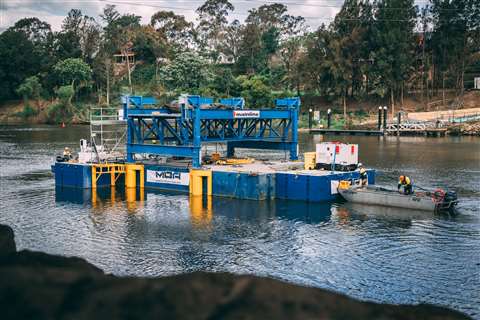 Mainline, using what it described as innovative systems to overcome challenges in the contract scope
Mainline, using what it described as innovative systems to overcome challenges in the contract scope
According to Mainline, the LnR deck removal method ensured very safe operations, almost no temporary bracing works, minimal preparation time and limited opportunity for demolition debris and slurry to enter the waterway.
The deck was removed progressively from the south, and the roadway was used as the landing “runway”.
For safe working at height, offset scaffolding was erected along the upstream, western edge, while the pedestrian pathway was retained for access and edge protection to the east.
The pedestrian pathway steel beams were retained as temporary bracing for the piers and removed later in concert with each pier.
Silt and containment curtains were deployed to capture flotsam and act as a visible barrier to river traffic. Workboats with spotters were always on the water.
Due to limited access and egress at the narrow north abutment landing, pier removal was delayed until bridge deck removal completion, while the Windsor South end was closed to demolition access.
The 7 m (23 ft) wide north roadway access was bounded on the west by retained bushland, to the south by the river and completed embankment works to the north.
Mainline innovative systems
Removal of the composite cast iron columns (concrete/brick/stone-filled), mass concrete diaphragm, and headstock, required the installation of a steel bracing cradle (AFP) with airbags attached to remove the whole pier as one integral unit.
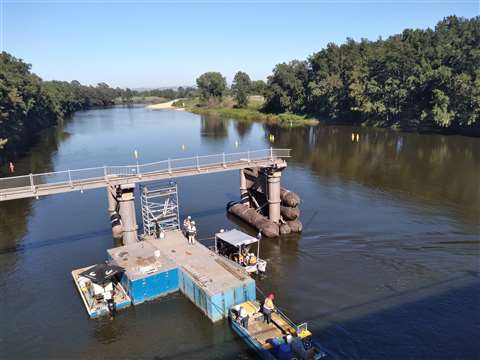 Airbags support the columns while creating the cut point without divers
Airbags support the columns while creating the cut point without divers
The 12 t steel AFP cradle was fitted with 9 m (29 ft 6 in) long and 1.5 m (5 ft) diameter airbags and stabiliser bags. Each bag provided 17 t buoyancy, which for the felled pier group was determined by total AFP weight, pier weight, and water depth.
The AFP was floated into position and self-erected by deflation/inflation of two vertical stabiliser bags on the outer side of the framework. The buoyancy auto-erection design eliminated cranage and significant on water rigging issues. Once the AFP was in place and tied off, the stabiliser bags were part reinflated to raise or correct the AFP into optimum vertical position with chains, binders, and large backing plates to spread chain loadings over the cast iron cylinder.
Critical positioning of the AFP into the riverbed determined the moment point for the cast-iron columns to fail when lateral pulling force was applied. All columns broke as planned below the level specified in the contract, except for one column on the final short pier. This was removed by divers. Some columns broke off much lower at bedrock.
The method of “cutting” (breaking) the columns below the riverbed was a significant safety and environmental initiative, and time saver.
There was no concrete slurry from column cutting, no diver cutting and pier stability was maintained until the removal stage.
Column lengths changed; up to 5 m longer due to the flood scouring just before commencement of works. Unfortunately, many of the columns were fractured historically.
Many fractures were not noted in reports or visible on inspection because of marine surface growth.
In some cases, the AFP overturned when broken columns slipped out of the cradle during movement to shore. This required salvage airbags recovery by divers.
Fortunately, Mainline was not using lifting processes where the loss of loads could result in catastrophic consequences.
No lost time or environmental issues
Demolition concepts and processes created by Mainline, eliminated reliance on heavy lifting on both water and land. Segmentation of deteriorated structures in the removal process was replaced by cradling of fully intact deck and pier sections, with no other cutting or separation.
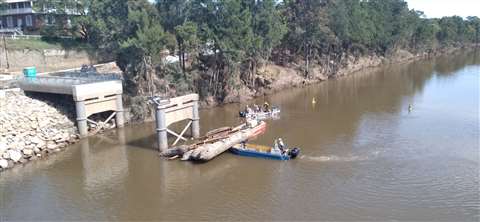 The project was completed with no lost time injuries or environmental contamination issues
The project was completed with no lost time injuries or environmental contamination issues
The key innovation was a combination of LnR deck span removal apparatus, and the FellnFloat AFP bracing cradle.
Mainline believes the apparatus provide certainty and limited opportunity for deteriorated bridge elements to fail during removal, where catastrophic lift failure could impact personnel, equipment, and the environment.
The lifting platform and the AFP “cradled” the larger pieces rather than apply localised forces at lift points. Removing large sections cradled by the lift platform or the AFP, eliminated the instability of cutting, temporary bracing inputs, and handling of many smaller structural elements.
The AFP totally supported the columns as well as creating the column cut point without divers.
Airbags were sized to accommodate the bridge width and section weight, for bridge loading.
The bridge deck was rolled on 1 m (3 ft) diameter and 5 m long airbags spaced approximately 2.5 m (8 ft) apart. This arrangement factored in a seven times safety factor for bag capacity.
The Mainline systems created a safer working environment by eliminating high-risk lifting of non-specific weights on water and onshore. Cradle and platform supported lifting of deteriorated elements significantly reduced health and safety and operational risks.
A key stakeholder was the local Windsor community. Mainline salvaged many bridge elements including ornate bridge crash rail pedestals, flanged caissons, bricks, concrete beam, and deck sections and two unique Lewis Bolt bedrock caissons anchors, and various other steel and bridge hardware. In total, over 100 t of salvage was delivered to the community for preservation, reuse, or repurposing.
The demolition was safely completed with no lost time injuries or personnel sick days, no disruption or injury to any navigational traffic and no environmental contamination issues for the duration of the works.
CONNECT WITH THE TEAM





